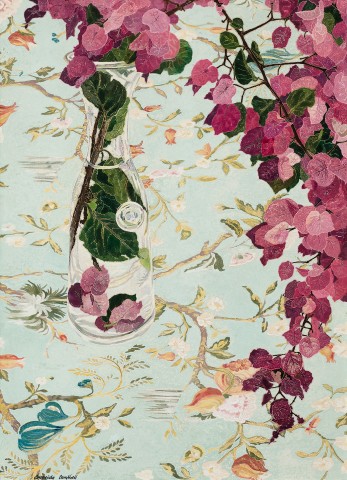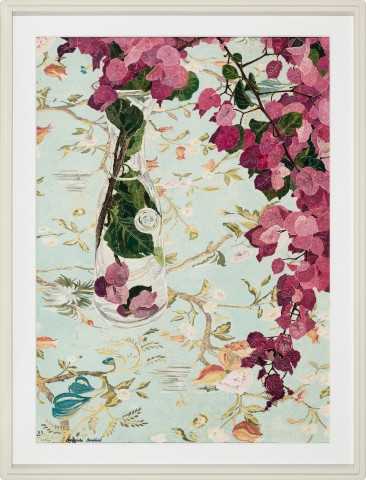Bougainvillea, 2003
Cressida Campbell
hand-painted unique woodblock print
83.0 x 60.0 cm
signed lower left: Cressida Campbell
Rex Irwin Art Dealer, Sydney (label attached verso)
Private collection, Sydney, acquired from the above on 29 April 2003
Cressida Campbell, Rex Irwin Art Dealer, Sydney, 29 April – 24 May 2003, cat. 6 (illus. in exhibition catalogue)
Timeless: The Art of Cressida Campbell, S.H. Ervin Gallery (National Trust), Sydney, 10 January – 22 February 2009; Queensland University of Technology Art Museum, Brisbane, 5 March - 19 April 2009
Low, L. A., 'Exhibitions', The Sydney Morning Herald, Sydney, 9 May 2003, p. 23
Crayford, P., The Woodblock Painting of Cressida Campbell, Public Pictures Pty Ltd, Sydney, 2008, cat. P0303, pp. 83 (illus. woodblock), 347
Bougainvillea, 2003 (Private collection), watercolour on incised woodblock, in Noordhuis-Fairfax, S. (ed.), Cressida Campbell, National Gallery of Australia, Canberra, 2022, pp. 161 (illus. detail), 239 (illus.)
Stretching diagonally from a simple glass carafe, a thorny cutting of red bougainvillea hangs above a resplendent Lampas tablecloth of sky blue, patterned with a motif of flowering and fruiting branches. In Bougainvillea, 2003, a unique watercolour print, celebrated printmaker Cressida Campbell has cropped and compressed the picture plane to create a flat surface of pure and harmonious pattern. With only a small handful of vigorous pictorial elements, Campbell’s still life cleverly pits a wild and unruly nature against its smoothed and edited representation in art.
Bougainvillea belongs to a small group of prints and painted woodblocks, created by Campbell in the late 1990s and early 2000s, featuring a decorative still life combination of flowers, fruit, ceramics and luxurious patterned fabrics. Amongst these are some of the artist’s most successful works, including Persimmons and silk, 1997; Nasturtiums, 2002 (Art Gallery of New South Wales); Plums with Indian cloth, 2004, and Ranunculus with painted cloth, 2010. As it had been for Margaret Olley, a longtime friend and supporter of the artist, the visual appeal of one’s own home generates for Campbell both a source of constant pleasure and an endless fount of subject matter. Consequently, almost all of Campbell’s still lives are semi-autobiographical, borne from her immediate environment and reflecting the many cultural inspirations of her life. Here, the Italian woven silk fabric, originally of Indian Mughal design, likely came from Campbell’s sister, designer Sally Campbell.1 The various textiles within the prints and painted woodblocks, from shibori fabrics to ikats, hand-painted silks and brocades, are mostly acquired through Sally’s imports, ‘I’m always buying them to use in my paintings’, the artist explained in 2011.2
Bursting from a sturdy wine decanter which wouldn’t be out of place serving house red in a Greek beachside taverna, the decorative profusion of the bougainvillea cannot be contained by the edges of the Campbell’s plywood block. In addition to the mottled texture of the printed watercolour paint happily evoking the plant’s distinctive papery blooms, the artist acknowledges the passing of time with subtle differences of colour. The wide range of red and pink hues conveys blooms past their prime on the desiccated tip of the branch and fallen into the water in the carafe, leached of their vibrancy.
Although she has asserted the importance of stylised design and pattern over subject matter in her artworks, Campbell had nevertheless acknowledged her remarkable ability to ‘draw plants pretty precisely, they’re like poems.’3 Botanical luxuriance formed the basis for the 18 prints shown alongside Bougainvillea in Campbell’s solo exhibition at Rex Irwin Art Dealer in 2003, their titles and subject matter including natives banksias and everlasting daisies, cliveas, orchids, peonies, monsteras, nasturtiums, jacaranda and orchids. Native to Latin South America and popular throughout the Mediterranean, the bougainvillea is a wild and unruly creeper, flowering in Sydney gardens from the first sign of spring right through to the end of summer. Never intended to be a cut flower, this specimen was likely a cutting from Margaret Olley’s viny garden in Paddington, offered as a suitably dramatic painting subject.4 Having applied an asymmetric composition, informed by Japanese pictorial technique, to a traditional still life expression of transient worldly pleasures, Campbell’s resulting image is striking and splendid.
1. Cressida Campbell, cited in Noordhuis-Fairfax, S. (ed.), Cressida Campbell, National Gallery of Australia, 2022, p. 48
2. Millar, A., ‘Artist in Residence’, Sydney Magazine, Sydney, April 2011, p. 83
3. Cressida Campbell, cited in Noordhuis-Fairfax, op. cit., p. 164
4. ibid.
LUCIE REEVES-SMITH


